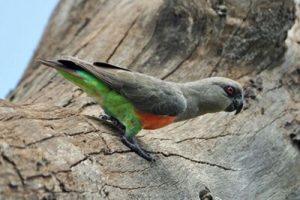What do Red-bellied parrot eat?
In personality, the Red Bellied Parrot is similar to Meyer’s and Senegal parrots. They are peaceful, affectionate, and humorous birds. Some people say they are easily scared.
The Red Belly is sexually dimorphic, which means that the male and female plumages are distinct. The male has an orange-red chest, whilst the female has more green and gray on her chest.
Some Red Bellied Parrots like to play with their toys while lying on their backs. They, like conures, have a playful attitude that requires a variety of toys to assault and gnaw on to keep them entertained. They enjoy swinging around on their toys while hanging by one toe.
The Red Bellied Parrot can be nippy at times and may go through a nippy stage when it reaches maturity. The friendship you build and try to keep will see you through the difficult times.
If they are not held and played with on a regular basis by more than one person, Red Bellied Parrots will easily become a one-person bird. They are warm and loving with those they know and enjoy receiving attention.

Capability to Communicate
The Red Bellied Parrot may learn to converse and make a variety of noises and sounds. Although Red Bellied Parrots might be quiet at times, they can also be extremely excited by new people and may speak or go wild to get attention!
If you’re interested, the organization that offers the aforementioned training program also offers a course on teaching your bird to talk.
Diet
Top-quality pellets should make up no more than 80% of the Red Bellied diet. We enjoy the Totally Organics Pellets because they are 100% organic and include no synthetic vitamins. This is critical if you have an allergic bird. Harrison’s Organic Pellets are another favorite of ours.
I recommend choosing one that is organic and not chemically dyed. Before anything artificial may be used, it must be cleansed by the kidneys. Many pellets are worthless.
The remaining 20% of their diet should include a seed blend, as well as dehydrated or fresh colored vegetables, beans, rice, and a little amount of fruit, ideally organic. Keep in mind that the toxins that are sprayed and fed to plants must be cleansed by their tiny kidneys. The Totally Organics All In One Seed Mix is an excellent option!
CAUTION: Never give your parrot wine, avocado, or chocolate – these can be fatal! Asparagus, eggplant, cabbage, caffeinated products, junk food, milk and cream, raw potato, and rhubarb (including the leaves) should also be avoided.
Keep in mind that the toxins that are sprayed and fed to plants must be cleansed by their tiny kidneys. Who knows what was fed and sprayed on the rest of it!
Despite what pellet makers would have you believe, parrots fed a range of fresh healthy meals are significantly happier and healthier.
Dehydrated fruits and vegetables are excellent when fresh fruits and vegetables are not available. Many birds enjoy the crunch of dried fruits and vegetables.
The best part is that they don’t spoil, so you can keep them in the cage for hours or even days. This is useful when trying to get kids to eat fruits and vegetables.
When you’re going to be home with them, wet them with warm water to deliver fresh-looking fruits and vegetables. This comes in helpful whether traveling or going on a trip!
Pure Water
On warm days, we supply bath water in the morning and sometimes in the evening, but we just leave it in there for one to two hours so they don’t drink bad water all day.
Purchase a water bottle as well. By ensuring they have clean water to drink that hasn’t been bathed or pooped in, you may avoid a slew of potential health issues.
If your Red Bellied Parrot has never used a water bottle, you will need to supply a water bottle as well as a dish until you see them drinking from the bottle.
If you’re concerned about safety, Lixit makes a glass water bottle with a wire rather than a spring to keep it in the cage. (On other bottles, some birds get their foot or beak stuck in the spring attachment.)
Requirements for Cages
Red Bellied Parrots, like conures, require a lot of space to climb and play. They require an abundance of toys that are changed out so that they do not become bored.
Consider purchasing a cage with a playpen on top for them to use when you are at home. They will be happier if they have more space.
A minimum of 18x18x24 cage is recommended. If your Red Bellied Parrot will be home alone all day, it will require ample space for a variety of toys as well as space to swing and play between them.
Some would claim that they should be kept in a small cage so that they will be glad to come out and play with you. That has not been an issue for us with our birds.
Because you are spending quality time with it, the bird will want to come out and be with you if your family becomes its flock. In my opinion, a spacious cage will not change your Red-Bellied parrot’s devotion for you.
Cages for veterinarian visits and outings
You should think about the type of carrier you will use to carry your Red Bellied Parrot. You never know when you’ll break down or decide to take your parrot on a trip. For these instances, invest in a comfy cage.